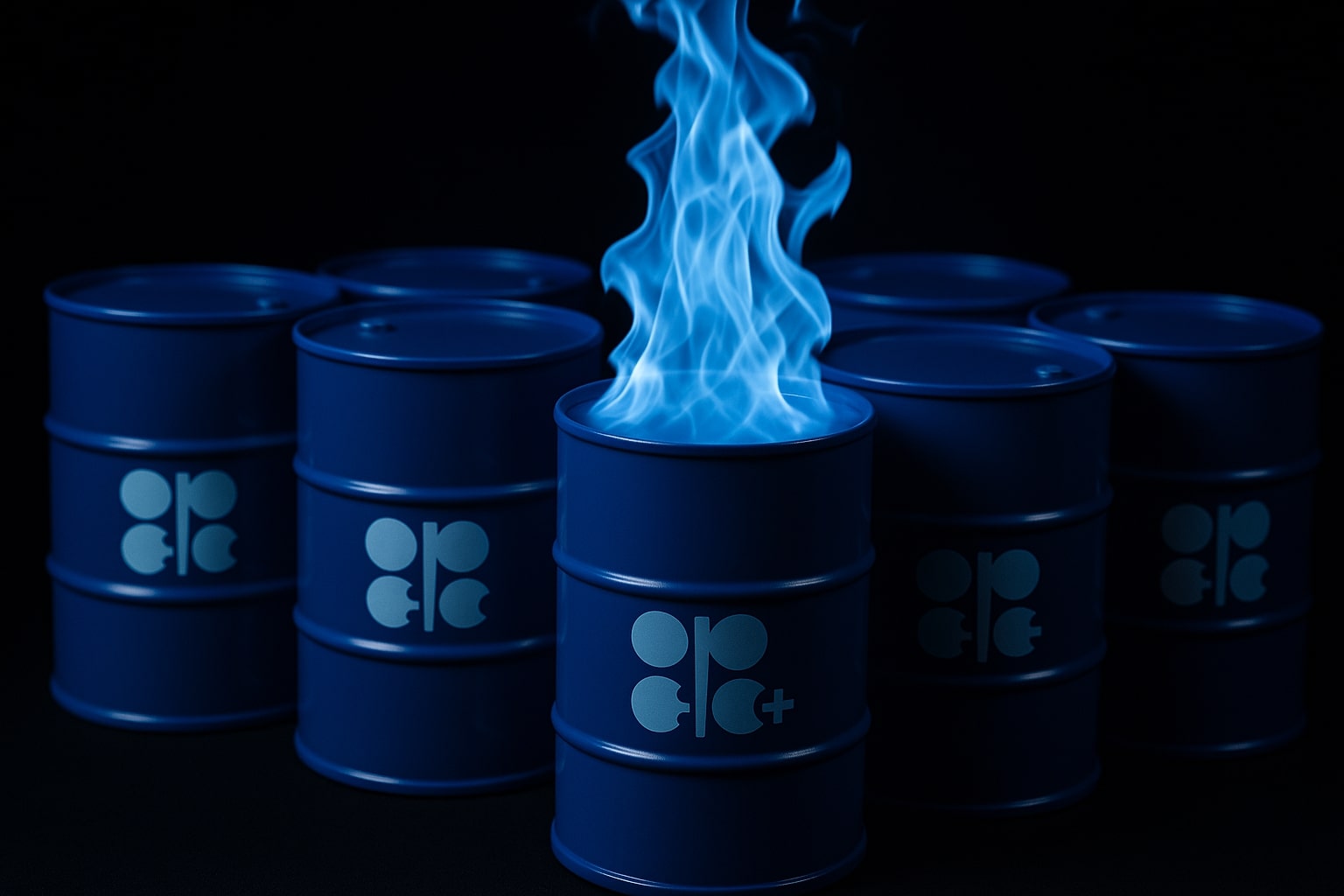
Oil Price Forecast - Oil Markets Slide: WTI (CL=F) Near $58, Brent (BZ=F) at $62 Amid OPEC+ Output Expansion
OPEC+ production growth, Russian supply recovery, and record U.S. inventories weigh on crude prices as WTI risks breaking $55 and Brent $59 amid global oversupply | That's TradingNEWS
WTI (CL=F) and Brent (BZ=F) Retreat Below Key Levels as OPEC+ Output Rises and Inventories Surge
West Texas Intermediate (CL=F) trades near $58.47, down 0.92%, while Brent crude (BZ=F) hovers at $62.63, losing 0.75% as growing evidence of oversupply, OPEC+ output expansion, and surging U.S. inventories pressure the global oil complex. Despite expectations for a late-year demand rebound, the data shows a clear imbalance between production and consumption. Refinery utilization and import levels remain historically elevated, suggesting that oil markets are heading into winter with more supply than the global economy currently needs.
Inventory Build Highlights Oversupply Risk
According to the latest EIA data (November 21, 2025), U.S. crude inventories rose by 2.8 million barrels to 426.9 million, far above consensus estimates for a draw. Gasoline stocks also jumped 2.5 million barrels to 209.9 million, and distillates increased to 112.2 million, confirming broad weakness in end-user demand. Crude imports surged to 2.84 million barrels per day, an 11-week high, while refinery utilization climbed to 92.3%, showing refiners continue processing near full capacity despite weaker consumption. This combination—high refinery runs, elevated imports, and stagnant drawdowns—creates the textbook definition of oversupply.
OPEC+ Strategy and Russian Supply Reinforce Bearish Pressure
OPEC+’s latest production guidance added 137,000 barrels per day for December, with members indicating no further cuts through Q1 2026. The policy shift, designed to “avoid under-supply” amid geopolitical uncertainty, risks deepening the imbalance. In parallel, Russia has restarted partial exports through previously restricted routes as U.S.-Russia diplomatic channels move toward a ceasefire framework in Ukraine. If sanctions relief expands, up to 600,000 barrels per day could return to global markets by early 2026.
These policy changes come as the IEA projects a 4 million-barrel-per-day global surplus in 2026, warning that structural oversupply could persist for multiple years unless demand rises or coordinated cuts resume. In the near term, these factors heavily cap upside potential for both WTI and Brent, regardless of short-term volatility spikes.
Price Action: Technical Structure Points to $55 WTI Support
WTI’s current range between $56.80–60.18 represents a consolidation phase at critical technical support. Analysts highlight that if $56.80 breaks, downside could accelerate toward $54.36–55.10, and potentially $51.67, the 2019 low. Resistance remains near $61.43–62.55, aligning with the 50-day exponential moving average and the upper boundary of the current trading channel.
For Brent, the primary support sits near $61, with a downside target at $58.90 if momentum selling continues. Momentum indicators, including RSI hovering around 38 and declining MACD histogram, suggest bearish continuation unless fresh supply-cut commitments emerge from OPEC+ in December.
In both contracts, trading volumes have fallen 12% week-over-week, signaling investor fatigue and reluctance to add exposure while fundamentals deteriorate.
Macro Factors: Weak Demand Meets High Refinery Throughput
U.S. gasoline demand remains under pressure, with four-week averages running 3.5% below last year, while diesel consumption continues to decline as freight activity weakens. Asian refiners, including India and China, are also operating near maximum capacity, increasing exports of refined products into already saturated markets.
Simultaneously, U.S. rig counts dropped to 407, the lowest since 2021, typically a bullish indicator. However, production resilience in Brazil, Guyana, and the North Sea offsets any decline from U.S. shale. The net effect is a stable to rising supply curve into 2026, while global oil demand is expected to increase by only 1.1 million barrels per day, half the rate seen in 2023–2024.
Investor Sentiment and Policy Outlook
Investor sentiment remains fragile. The probability of a Federal Reserve rate cut in December (85%) offers limited relief, as lower rates may support financial assets but do little to absorb physical supply. Traders are now focused on OPEC’s December 3 meeting, where discussions around coordinated output restraint could define short-term direction. Absent new cuts, analysts see WTI drifting toward $55 and Brent toward $59, testing mid-2023 price levels.
In the options market, open interest on WTI $55 puts for January delivery rose 18% this week, indicating hedging against further downside. Meanwhile, institutional long positions have declined 7%, the sharpest weekly reduction since July.
Read More
-
Robinhood Stock Price Forecast - HOOD Shares Rockets Past $128 After 270% Profit Jump
27.11.2025 · TradingNEWS ArchiveStocks
-
XRP Price Forecast - XRP-USD Climbs to $2.21 as XRP ETF Demand Surges and UAE Greenlights RLUSD Stablecoin
27.11.2025 · TradingNEWS ArchiveCrypto
-
Gold Price Forecast - XAU/USD Holds Above $4,150 as Rate-Cut Bets, Liquidity Flows Drive Bullish Momentum
27.11.2025 · TradingNEWS ArchiveCommodities
-
Stock Market Today - Dow 47,427 and Nasdaq 23,214 — Fed Cut Bets Power DELL, HOOD, and URBN in Holiday Rally
27.11.2025 · TradingNEWS ArchiveMarkets
-
GBP/USD Price Forecast - Pound Holds Above 1.32 as Fed Rate Cut Bets and U.K. £22B Fiscal Cushion Lift the Pound
27.11.2025 · TradingNEWS ArchiveForex
Medium-Term Forecasts: Structural Bear Trend Intact
According to JPMorgan Chase & Co., the medium-term base case now projects WTI at $53/barrel and Brent at $57/barrel by 2027. This forecast assumes OPEC+ compliance drifts and global demand normalizes below pre-pandemic trajectories. The more pessimistic scenario, modeled by Barron’s and the IEA, anticipates Brent briefly falling into the $30s if coordinated production discipline fails.
In contrast, a bullish reversal would require multiple aligned catalysts—accelerating Chinese demand, unexpected OPEC+ restraint, or a rapid depletion of U.S. inventories—all currently absent from data trends.
Strategic Positioning and Risk Outlook
Short-term traders are watching the WTI $56.80 level as a key inflection point. A sustained break below could open a direct path to $54.50, triggering stop-loss selling. Conversely, a close above $61.50 could invalidate the bearish setup and invite short covering.
Macroeconomic headwinds—particularly weaker European industrial output and slowing U.S. freight demand—suggest the path of least resistance remains downward. As refiners maintain high throughput and inventories build, the marginal barrel is finding fewer buyers.
Verdict: Sell — Oversupply and OPEC+ Expansion Reinforce Bear Market Bias
The data confirms that both WTI and Brent are structurally oversupplied. Rising U.S. inventories, OPEC+ expansion, Russian export normalization, and sluggish demand all converge to form a bearish outlook. Unless OPEC+ reverses course in December, the probability of WTI revisiting $55–54/barrel and Brent testing $59/barrel is high.
WTI (CL=F) — Bearish bias below $60, downside target $54–55
Brent (BZ=F) — Bearish bias below $63, downside target $59–60
Investment view: Short-term rallies should be treated as corrective. The structural supply glut and weak demand trajectory support maintaining a Sell stance into Q1 2026.



















